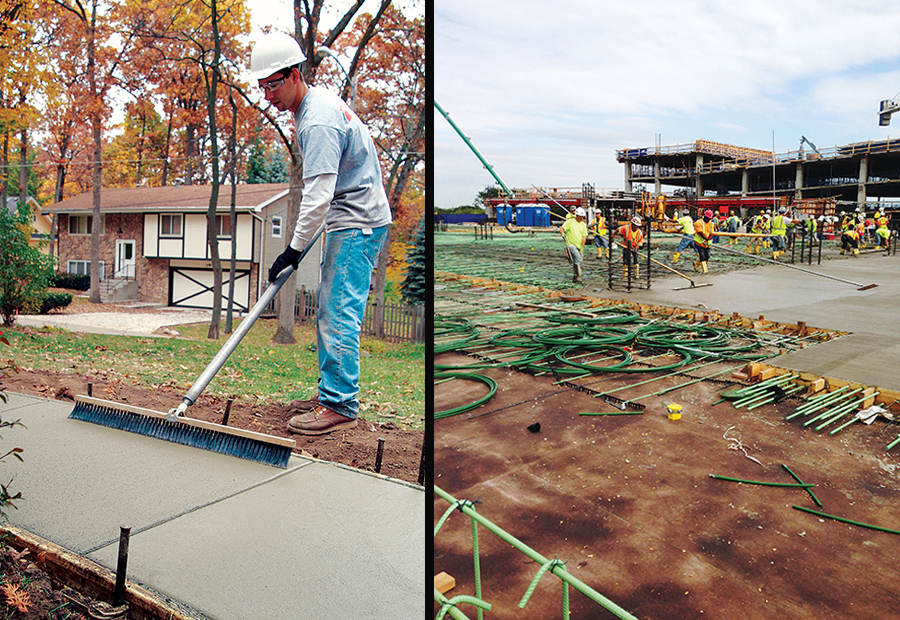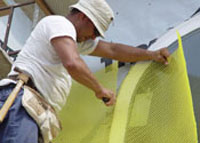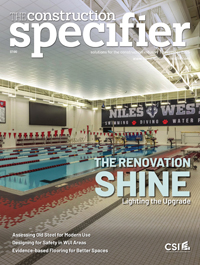Specifying broomed exterior concrete surfaces
Measured flatness on various broomed
surface measurements
In 2009, Dave Schiable (Baker Concrete) and Scott Tarr and David Scott (Concrete Engineering Specialists [CES]) conducted a series of tests on broomed surfaces of an industrial paving project at Baker’s main office in Monroe, Ohio. The variables for the broomed surface measurements were:
- concrete mix: 28 mPa (4000 psi), 339 kg/m3 (564 lb/cy) of cementitious, four to seven percent air content, slump 150 to 200 mm (6 to 8 in.);
- weather conditions: air temperature of 21 C (70 F), RH 67 percent, sunny;
- broom texture: light, medium, heavy;
- finishing technique: (A) hand screed with 4.8-m (16-ft) long magnesium straightedge, 1.2-m (4-ft) wide magnesium bullfloat, 900-mm (36-in.) wide broom; (B) hand-held 3.6-m (12-ft) long vibrating screed, 1.2-m wide magnesium bullfloat, 900-mm wide fresno, and 900-mm wide broom; (C) hand-held 3.6-m (12-ft) vibrating screed, 4-ft wide magnesium bullfloat, 900-mm walk-behind machine with float shoes, 900-mm wide fresno, 900-mm wide broom; and
- measurement devices: dipstick with points and pads for feet, F-meter.
Although this study produced many different flatness measurements, only selected test results are shown here. Two separate placements were made, each on a different day. The first was a bullfloat-only surface—one section remained unbroomed, and another three sections received light, medium, or heavy brooming. The measured flatness for the bullfloat-only surface was FF 18.5, while subsequent light, medium, and heavy brooming over that bullfloated surface resulted in FF of 18.7, 17.5, and 14.5, respectively. Thus, it appears the bullfloat-only broom surface was close to the maximum FF of 20 predicted by Stephan’s data, but textures produced by medium or heavy broom finishing decreased the flatness.
The second placement featured finishing techniques A, B, and C, again with light, medium, and heavy broom textures. Figure 1 shows the flatness resulting from the three finishing techniques used during the second placement. As mentioned, the finishing technique for Type A involved the least amount of finishing consisting only of a screed, bullfloat, and broom while Types B and C included more finishing tools and techniques. Figure 1 shows the least amount of finishing, Type A, produced the highest flatness. Surprisingly, differences in broom texture did not have as great an effect on F-numbers in this set of data as they did on the concrete placements previously discussed.

Drainage
It is appropriate to consider drainage after the discussion
of flatness because specifiers often state a flatness tolerance either by selecting a gap under a 3-m (10-ft) straightedge or an FF value—neither of which is consistent with another common specification related to drainage. For instance, a straightedge flatness tolerance of a 6-mm gap in 3 m (¼ in. in 10 ft) is essentially describing the allowable depth of water in a ‘bird bath’ (i.e. puddle). If the specification also prohibits bird baths or water ponding, the two requirements are incompatible.
The American Society of Concrete Contractors (ASCC) Position Statement 7, “Bird Baths on Concrete Slabs” showed bird baths are the unavoidable consequence of having a surface tolerance, even if the surface is sloped. This position statement was based on an article, “Birdbaths: Expectations vs. Reality,” by Suprenant in ACI’s Concrete International.
Even if there are some bird baths, drainage design is important in conveying rainwater from a parking lot or parking garage through a drain system to an appropriate discharge location. There are a few primary factors in drainage design affecting both the economics of the drainage design and performance of the drainage system. The two primary factors are direction and magnitude of surface slope.



